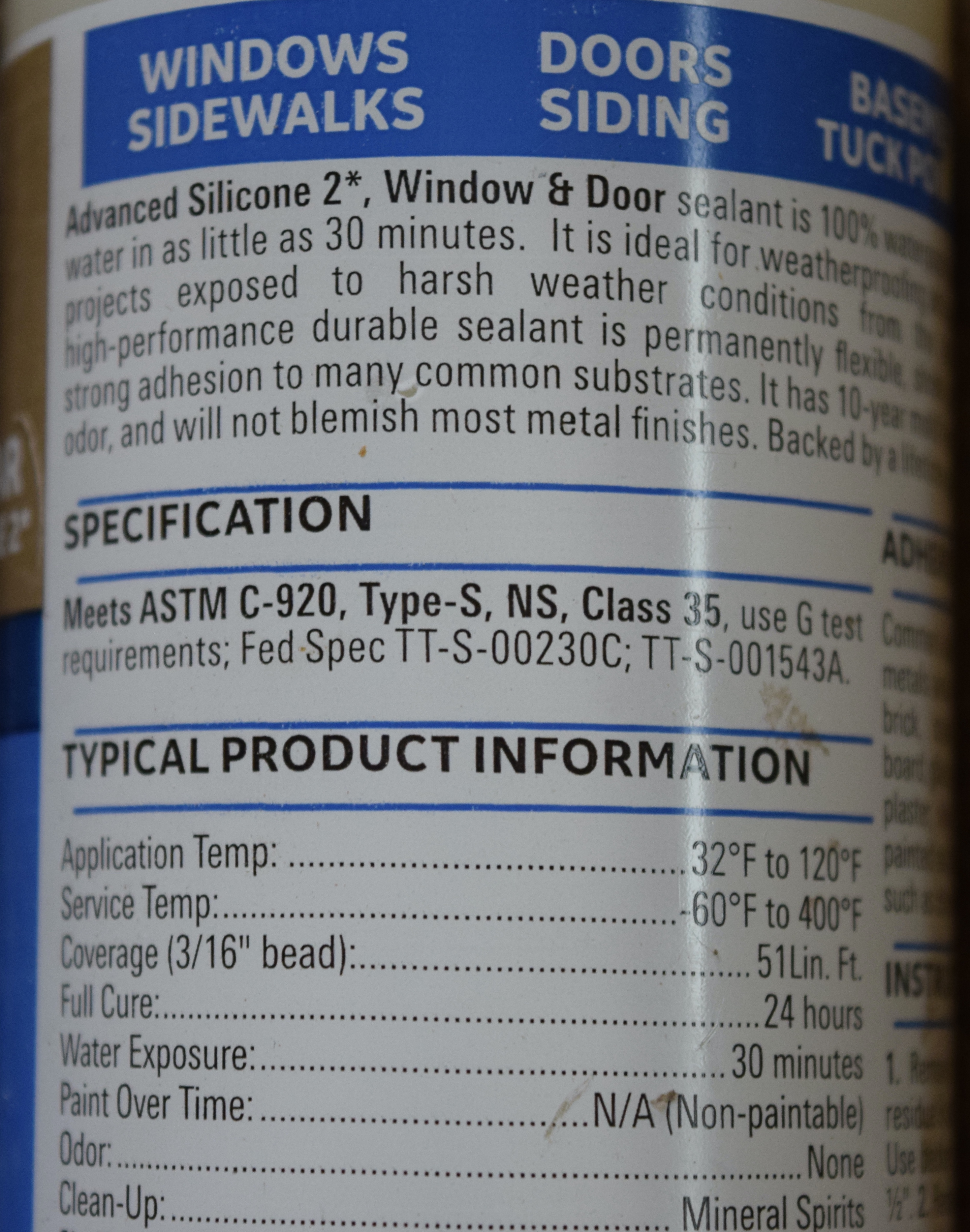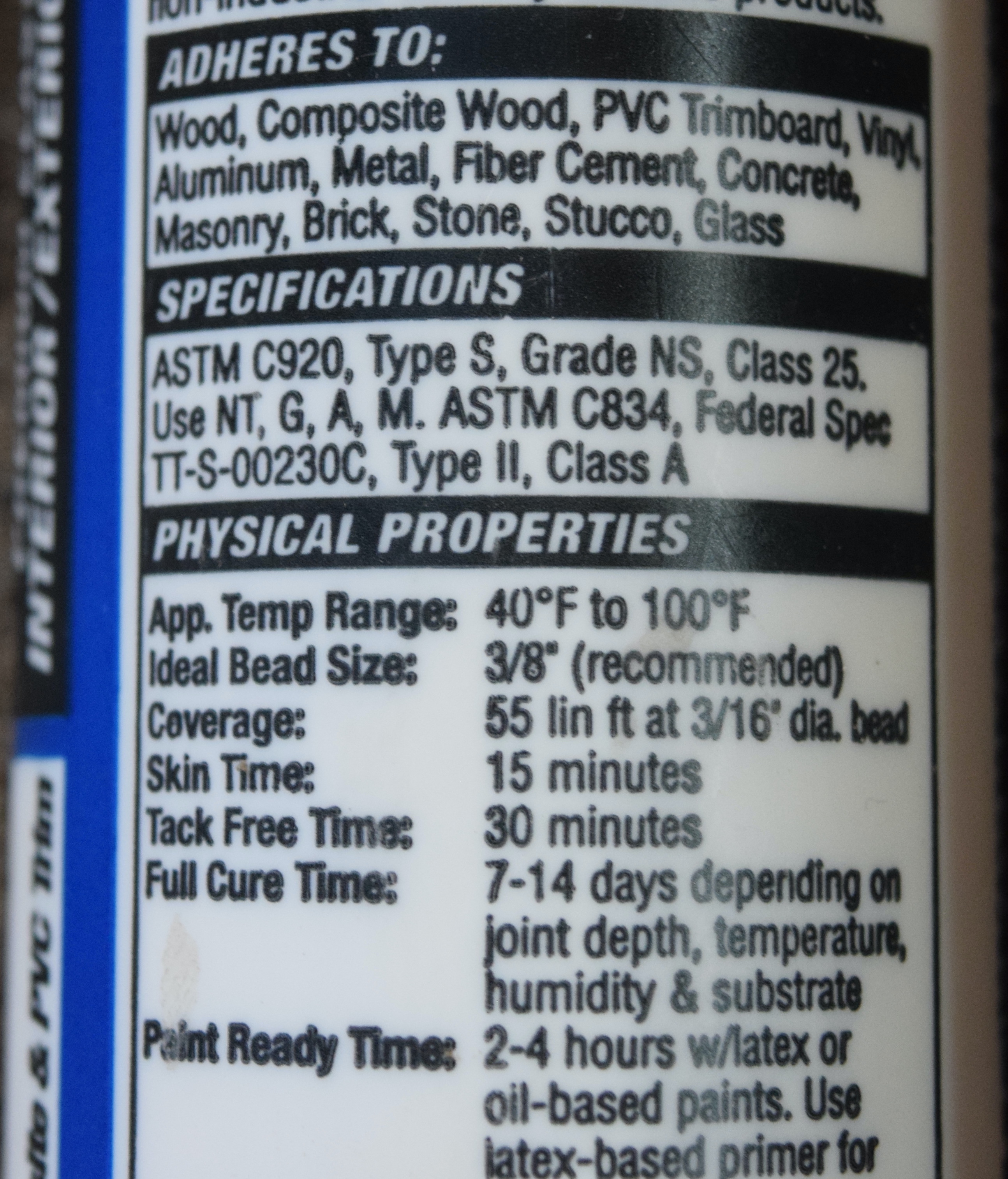You should perform an annual inspection that will help prevent unnecessary damage to your investment. A big part of that inspection has to do with sealants and caulking around windows, doors, and other penetrations around your home. There are two intimidating problems facing homeowners when it comes to this type of maintenance. First, you have to know what product to buy and use on your home. Second, you have to know how to apply the products. We are going to try and break this all down for you into 2 comprehensive articles. Let's get started.
Choosing the Right Exterior Caulk or Sealant
The terms "Caulk" and "Sealant" are frequently used interchangeably. The key distinction between caulk and sealant is Elasticity. Caulk is typically made from a mixture of latex and acrylic materials, which make it more rigid and prone to shrinking when cured.
A Sealant offers superior elasticity and water resistance because of the material it is made of. The material allows a sealant to easily expand and contract during changing temperatures without losing its airtight/watertight seal. Sealants are the best choice for areas that experience frequent weather fluctuation and high moisture levels, such as on the exterior around penetrations, doors, and windows, as well as kitchens, and bathrooms. The two most important factors to keep in mind when selecting a caulk or sealant are the temperature range and moisture level at the area of application.
For the exterior, it is recommended to use caulks and sealants that remain permanently flexible. Look for the words “permanently flexible” written clearly on the label or in the accompanying product literature. For best results, use one of the following:
- Elastomeric Joint Sealant complying with ASTM C920 Grade NS, Class 25 or higher (listed on the product label)
- Latex Joint Sealant complying with ASTM C834 (listed on the label)
Caulking/sealant must be applied in accordance with the caulking/sealant manufacturer’s written instructions.
Types of Caulk
100% Silicone - A 100% silicone sealant bonds to porcelain, ceramic, marble, fiberglass, and most metals. It is ideal for wet, exterior applications because it’s extremely weather-resistant and typically contains antimicrobial properties that will inhibit the growth of mold and mildew. Silicone is also UV-resistant, which protects against yellowing and allows a seal to last longer when exposed to direct sunlight. Most silicone is NOT paintable.
As its name suggests, it is a synthetic rubber made from a combination of pure silicone and oxygen atoms. Its chemical structure means that silicone forms longer molecular chains than alternative sealants like acrylic latex or polyurethane caulk. Silicone typically takes 24 hours to cure.
Polyurethane Caulk - Polyurethane sealants are among the most widely used technology for both new and renovation construction projects. Available in single and multi-component formulations, polyurethane sealants are mainly used in horizontal joints or non-sagging, vertical applications. In particular, these include Isolation joints, Roofing, Foundation, Gutters, Expansion, and Control Joints.
Polyurethane sealants are flexible and versatile construction sealants appropriate for a number of surfaces like wood, metal, plastic, masonry, aluminum, stucco, and much more. The joints are watertight and flexible under most weather conditions, making them perfect for sealing gaps and joints on the exterior of structures.
Use polyurethane caulk when you are caulking wood or another surface that must be painted. Some polyurethane caulking is NOT paintable so be sure to select the correct product...read the label.
Polyurethane will adhere very well to most surfaces but it will not hold up as well as silicone caulk in high sunlight exposure. Most manufacturer warranties last for five years but you can expect up to ten years if sunlight exposure and joint movement are minimal. It is easier to clean up than silicone caulk and takes about 24 hours to dry completely. Once dry, it can be difficult to remove.
Elastomeric or Acrylic Urethane Caulk - High-performing Acrylic Urethane sealant is ideal for sealing a wide variety of interior & exterior surfaces. It is specially formulated to stretch ensuring the seal does not crack or lose adhesion making it perfect for most sealing projects including windows, doors, trim, siding, gutters, flashing, sinks, and countertops.
Latex Caulk - Latex caulk, also known as acrylic latex or general-purpose caulk, is water-based and provides excellent adhesion to most common building materials, including wood. Unlike a silicone sealant, it IS paintable once cured, produces fewer fumes, and can be cleaned up with mild soap and water rather than a chemical solvent.
This type of caulk is easier to apply. However, acrylic-latex caulks only provide a moderate level of water resistance, making them better suited for interior applications without repeated exposure to water. They are used on the exterior of homes to seal around siding to windows and exterior trim to siding. Acrylic-latex caulks can take up to 72 hours to reach full cure.
Tub-N-Tile caulk, a specialty acrylic-latex caulk, includes an advanced mildewcide, defending against mildew growth in damp areas. Some common plumbing applications for regular and specialty acrylic-latex caulk include:
- Securing loose tiles
- Caulking bathtubs, showers, sinks, and toilets (due to moisture this area will require frequent maintenance)
- Sealing crown molding and baseboards
- Sealing gaps around plumbing fixtures
Siliconize Acrylic Latex - This hybrid caulk provides a waterproof seal that will not crumble or shrink when changes in temperature occur, making it both flexible and durable. It is also made to dry quickly (only 24 hours) and glide smoothly on surfaces for shaping and blending. Common uses include:
- Bathtub and shower surrounds
- Backsplashes
- Sealing exterior siding
- Reducing window and door drafts
Butyl Caulk - Butyl Rubber Caulk is a high-performance product that is ideal for sealing exterior gutters, corrugated roofing, pipes, aluminum, vinyl siding, lap joints, flashing, roof vents, and drain spouts. Provides a watertight seal for areas exposed to the elements. For use on aluminum/metal, concrete, mortar, plastics, rubber, stone, vinyl, and wood. Butyl rubber sealant also stands out for its outstanding oil and gasoline resistance.
Butyl sealant is a synthetic rubber caulk based on the polymerization of isobutylene with isoprene. It has high resistance to weather, ozone, and chemicals in general, which makes it almost unbreakable for outdoor usage.
Polyisobutylene is the main ingredient in butyl caulks. It forms a good seal and is very flexible, which makes it ideal for creating weatherproof seals that can expand and contract without fracturing.
Products to Consider
Window/Door Installation, Penetrations, Flashings, Siding & Trim
DAP Dynaflex 230 is a great product to use on the exterior. It is a premium elastomeric latex sealant with silicone-like toughness. It combines outstanding durability, adhesion, and flexibility with easy tooling, paintability, and low odor & water clean-up. It is highly flexible to handle joint movement caused by variations in temperature and humidity without cracking. It provides a long-lasting, durable seal that is 100% waterproof and weatherproof. Ideal for sealing air leaks around windows, doors, siding, trim, and baseboards to improve the energy efficiency of a home and reduce utility costs. Cured sealant is mold and mildew-resistant. Meets ASTM Specification C920 & C834.
Wood, Metal, Vinyl Siding, Drywall/Plaster, Glass, and Plastic
GE All-Purpose 100% Silicone sealant is 100% waterproof and ideal for a wide range of projects exposed
to harsh weather from the attic to the basement. Permanently flexible, it can stretch and move
with expansion and contraction and will never break down due to ultraviolet rays or freezing temperatures. This high-quality sealant is resistant to unsightly stains causing mildew growth. It’s easy to apply and offers excellent adhesion to many common building materials. Meets ASTM Specification C920.
Trim, Corner Joints, Siding, Molding, Interior Window/Door Frames
DAP® ALEX PLUS® ALL PURPOSE ACRYLIC LATEX CAULK PLUS SILICONE is an excellent quality, all-purpose caulk for sealing a wide variety of interior and exterior surfaces. It contains silicone additives for greater flexibility and adhesion and shrinks less* for a durable, waterproof seal. ALEX PLUS® is paintable in just 30 minutes with latex or oil-based paints, saving time. It won’t shine through or discolor the paint for superior paint finish results. It is easy to apply and tool, low in odor and cleans up easily with water. Cured caulk is mold and mildew-resistant. 40 Year. Exceeds ASTM C834. Interior/exterior use.
Windows, Doors, Siding, Penetrations, Sound Proofing
Sashco Big Stretch is a high-performance water-based elastomeric sealant with powerful adhesion and superior elasticity. It spans gaps up to 2” wide and stretches up to 500% of the original joint size without cracking. Meets ASTM Specification C834 and C920.
Green/Damp Concrete, Small Joints, Windows/Door Frames, Flashings, Roofing
Sikaflex®-1A polyurethane is a premium-grade, high-performance, moisture-cured, 1-component, polyurethane-based, non-sag elastomeric sealant. Sikaflex-1a can be used in green and damp concrete applications. Meets ASTM C-920, Type S.
- USES
▪ Designed for all types of joints where maximum depth of sealant will not exceed 1/2 in.
▪ Excellent for small joints and fillets, windows, door frames, reglets, flashing, common roofing detail applications, and many construction adhesive applications.
▪ Suitable for vertical and horizontal joints; readily placeable at 40°F
▪ Has many applications as an elastic adhesive between materials with dissimilar coefficients of expansion.
Gutters, Metal Roofing, Flashing, Roof Vents
White Lightning® Butyl Rubber Caulk is a high-performance product that is ideal for sealing exterior gutters, corrugated roofing, pipes, aluminum, and vinyl siding, lap joints, flashing, roof vents, and drain spouts. Provides a watertight seal for areas exposed to the elements. For use on aluminum/ metal, concrete, mortar, plastics, rubber, stone, vinyl, and wood. Provide a watertight seal, remains flexible in temperature extremes.
Sealing It Up
So as you can see, there are many types of caulk and sealants and it really depends on your application. We covered a lot of different products and their uses and my hope is that you feel less overwhelmed when selecting a caulk or sealant for your job. Next, we want to walk you through the proper process of applying these products step by step. Check out part 2 of Demystifying and maintaining exterior sealants and caulking.


